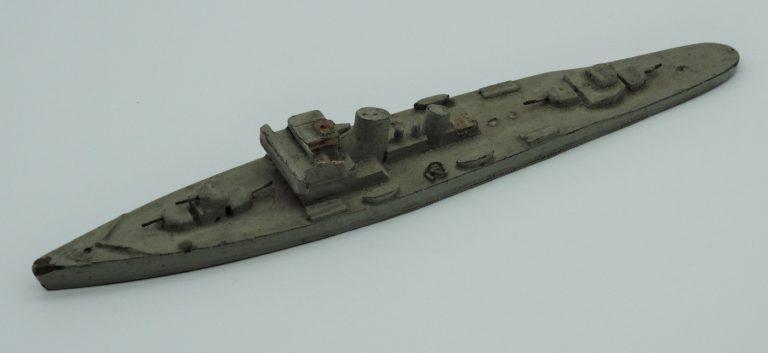Model Ship from Oliver Hill Miniature Range
Live firing of coast artillery weapons in peacetime was infrequent due to both cost and limiting barrel wear. Loading and ammunition handling drills could be practiced with dummy rounds of equivalent weight. Target identification and engagement was practiced using a miniature range. One feature of the miniature range was scale models of potential enemy warships The model displayed is 265 mm long, 42 mm wide and 30 mm high, It is constructed of balsa and pine and painted a shade of naval grey. It shows evidence of handling through discolouration at the bow and stern. Miniature ranges were used for low cost training in both field and coast artillery. For coast artillery in the 1930s, the reference for the construction and operation of the miniature range was Miniature range for instruction in ranging coast artillery guns (counter-bombardment) 1932 published by HMSO in London. It was a 13 page manual with 6 leaves of illustrations. Unfortunately, a copy is not available locally.
The model is the only known surviving relic from the miniature range associated with the 9.2 inch gun battery at Oliver Hill, Rottnest. The miniature range itself remains as vestigial footings outside the entrance to the Plotting Room. The choice of a Japanese cruiser as one of the target models for the Oliver Hill miniature range is a clear indication of the strategic assessment of potential enemies. This is also borne out by references to Japan in the Committee of Imperial Defence Reports on Australian coastal fortifications from the 1920s and 30s. The turret configuration on the model enables easy identification. The three single turrets in a pyramid configuration forward and aft and funnel details identify the model as that of the Kako Class cruiser of the Imperial Japanese Navy. This configuration permitted a six-gun broadside but only 2 guns could fire directly ahead or astern.
The details of the two ships of this class can be found in Jane’s Fighting Ships 1932 on pages 327 and 328.as HIJMS Kako and HIJMS Furutaka Jane's Fighting Ships is an annual book of information on all the world's warships arranged by nation, including information on ships' names, dimensions, armaments, silhouettes and photographs, etc. Each edition describes and illustrates warships of different national naval and paramilitary forces, providing data on their characteristics. The first issue was illustrated with Jane's own ink sketches, Photos began to appear with the third volume in 1900. The present title was adopted in 1905. Until the 1956/57 edition, Jane’s Fighting Ships were in a landscape format. The publication then changed to portrait to match Jane’s All the World’s Aircraft. Beginning in the early 2000s, Jane's has also been published online.
The main armament of the Kako class as launched was six 8 inch guns. Kako and her sister ship Furutaka were the first generation of high speed heavy cruisers in the Japanese navy. They were intended to counter the US Navy Omaha class scout cruisers and Royal Navy Hawkins class heavy cruisers. Both ships were launched in 1925 and had a displacement of 7,100 tons, a length of 580 feet and a crew of 604. The ships were not a successful design and had propulsion and stability issues. In 1936/37, the armament of both ships was replaced by three 203.2 mm (8 inch) twin turrets, 2 forward and one aft. Kako was sunk during the Battle of Savo Island on 10 August 1942. Furutaka was sunk on 12 October 1942 at the Battle of Cape Esperance. This model is roughly to a scale of 1 inch to 60 feet. Cast models on the scale of 1 inch to 100 feet or 1 inch to 110 feet (1:1320 in metric) of this class and many other warships were produced during World War 2 and also commercially post 1945 by the firm Comet.
https://www.worthpoint.com/worthopedia/ww-ii-japanese-heavy-cruiser-kat… View of the three-turret pyramid configuration



